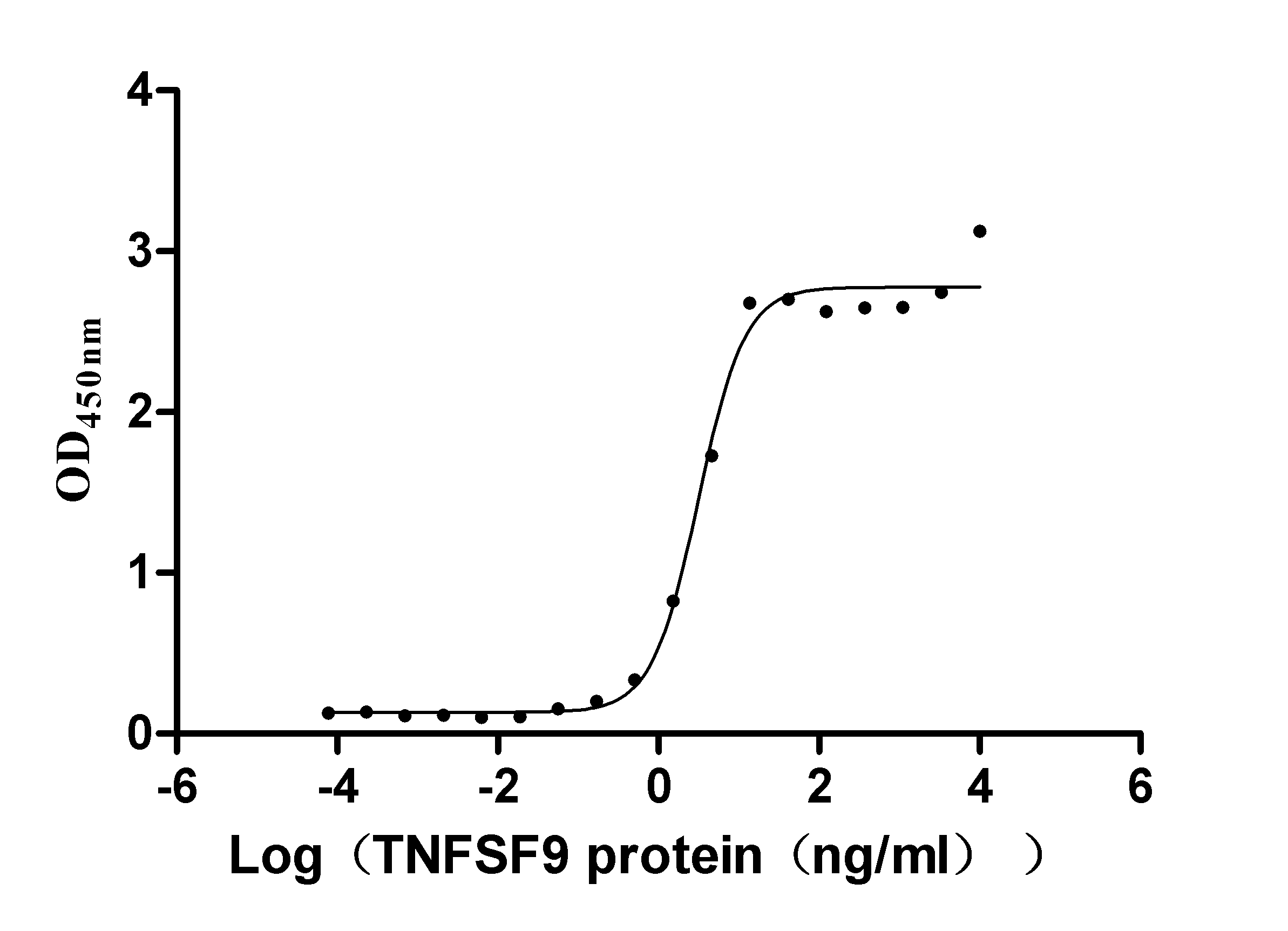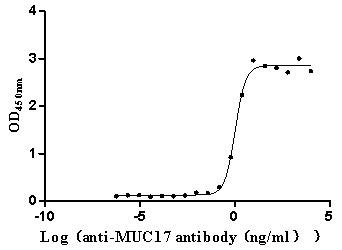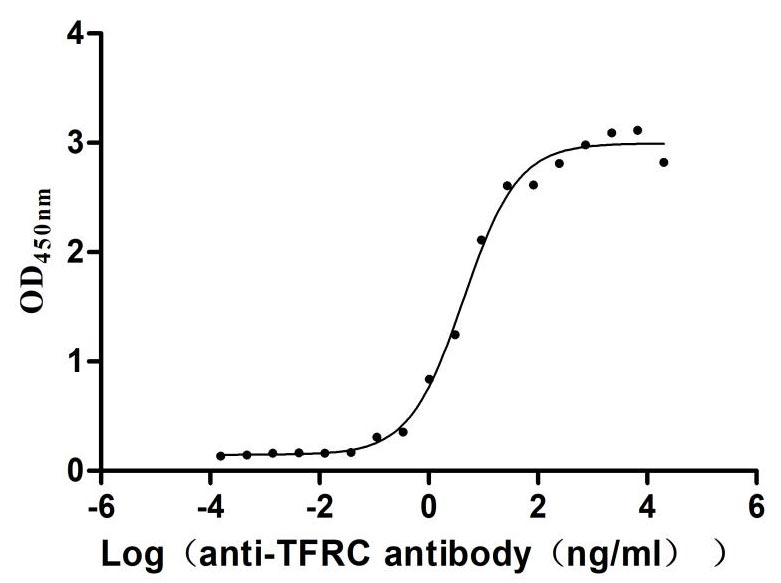Recombinant Human Pituitary adenylate cyclase-activating polypeptide (ADCYAP1)
-
中文名称:Recombinant Human Pituitary adenylate cyclase-activating polypeptide(ADCYAP1),Yeast
-
货号:CSB-YP001346HU
-
规格:
-
来源:Yeast
-
其他:
-
中文名称:Recombinant Human Pituitary adenylate cyclase-activating polypeptide(ADCYAP1),Yeast
-
货号:CSB-EP001346HU
-
规格:
-
来源:E.coli
-
其他:
-
中文名称:Recombinant Human Pituitary adenylate cyclase-activating polypeptide(ADCYAP1),Yeast
-
货号:CSB-EP001346HU-B
-
规格:
-
来源:E.coli
-
共轭:Avi-tag Biotinylated
E. coli biotin ligase (BirA) is highly specific in covalently attaching biotin to the 15 amino acid AviTag peptide. This recombinant protein was biotinylated in vivo by AviTag-BirA technology, which method is BriA catalyzes amide linkage between the biotin and the specific lysine of the AviTag.
-
其他:
-
中文名称:Recombinant Human Pituitary adenylate cyclase-activating polypeptide(ADCYAP1),Yeast
-
货号:CSB-BP001346HU
-
规格:
-
来源:Baculovirus
-
其他:
-
中文名称:Recombinant Human Pituitary adenylate cyclase-activating polypeptide(ADCYAP1),Yeast
-
货号:CSB-MP001346HU
-
规格:
-
来源:Mammalian cell
-
其他:
产品详情
-
纯度:>85% (SDS-PAGE)
-
基因名:ADCYAP1
-
Uniprot No.:
-
别名:ADCYAP1Pituitary adenylate cyclase-activating polypeptide; PACAP) [Cleaved into: PACAP-related peptide; PRP-48); Pituitary adenylate cyclase-activating polypeptide 27; PACAP-27; PACAP27); Pituitary adenylate cyclase-activating polypeptide 38; PACAP-38; PACAP38)]
-
种属:Homo sapiens (Human)
-
蛋白长度:Cytoplasmic domain
-
表达区域:82-129
-
氨基酸序列DVAHGILNE AYRKVLDQLS AGKHLQSLVA RGVGGSLGGG AGDDAEPLS
-
蛋白标签:Tag type will be determined during the manufacturing process.
The tag type will be determined during production process. If you have specified tag type, please tell us and we will develop the specified tag preferentially. -
产品提供形式:Lyophilized powder
Note: We will preferentially ship the format that we have in stock, however, if you have any special requirement for the format, please remark your requirement when placing the order, we will prepare according to your demand. -
复溶:We recommend that this vial be briefly centrifuged prior to opening to bring the contents to the bottom. Please reconstitute protein in deionized sterile water to a concentration of 0.1-1.0 mg/mL.We recommend to add 5-50% of glycerol (final concentration) and aliquot for long-term storage at -20℃/-80℃. Our default final concentration of glycerol is 50%. Customers could use it as reference.
-
储存条件:Store at -20°C/-80°C upon receipt, aliquoting is necessary for mutiple use. Avoid repeated freeze-thaw cycles.
-
保质期:The shelf life is related to many factors, storage state, buffer ingredients, storage temperature and the stability of the protein itself.
Generally, the shelf life of liquid form is 6 months at -20°C/-80°C. The shelf life of lyophilized form is 12 months at -20°C/-80°C. -
货期:Delivery time may differ from different purchasing way or location, please kindly consult your local distributors for specific delivery time.Note: All of our proteins are default shipped with normal blue ice packs, if you request to ship with dry ice, please communicate with us in advance and extra fees will be charged.
-
注意事项:Repeated freezing and thawing is not recommended. Store working aliquots at 4°C for up to one week.
-
Datasheet :Please contact us to get it.
靶点详情
-
功能:Binding to its receptor activates G proteins and stimulates adenylate cyclase in pituitary cells. Promotes neuron projection development through the RAPGEF2/Rap1/B-Raf/ERK pathway. In chromaffin cells, induces long-lasting increase of intracellular calcium concentrations and neuroendocrine secretion. Involved in the control of glucose homeostasis, induces insulin secretion by pancreatic beta cells.
-
基因功能参考文献:
- that perturbations in the PACAP-PAC1R pathway may be involved in amyotrophic lateral sclerosis pathology PMID: 28926110
- Results have suggested that pituitary adenylate cyclase-activating polypeptide (PACAP) and vasoactive intestinal peptide (VIP), but predominantly VIP, induce neuroblastoma differentiation into benign form by regulating hypoxia-inducible factors, vascular endothelial growth factor and vascular endothelial growth factor receptor expression and distribution. PMID: 29699729
- human migraine models have shed light on the importance of PACAP38 in the pathophysiology of primary headaches PMID: 29453754
- PACAP stimulated repairing of corneal endothelium lesion as shown by wound healing analysis. PMID: 29126993
- Studies suggest that the level of stress and circulating gonadal hormones may differentially regulate the PACAPergic system in males and females to influence anxiety-like behavior and may be one mechanism underlying the discrepancies in human psychiatric disorders. [Review Article] PMID: 28610473
- Study indicates that both exogenous and endogenous pituitary adenylate cyclase activating polypeptide plays a regulatory role in small intestinal cells, but this is restricted to certain conditions, such as type of stressor and timing of application. PMID: 28698051
- Some abnormalities of the PACAP system are evident in the brains of Sudden Infant Death Syndrome infants. PMID: 28392470
- Study found that interictal serum PACAP levels are not increased (or decreased) in a large series of chronic migraine women when compared to matched controls without a headache history PMID: 27634731
- An association was found in a common variant of the PACAP receptor in patients with cluster headache. PMID: 27957625
- It has potent neuroprotective and neuroregenerative functions. (review) PMID: 27324639
- PACAP-38 is released in plasma during attacks of episodic cluster headache patients. PMID: 27475101
- Hypermethylation of ADCYAP1 gene may be highly associated with the development of cervical cancer. PMID: 26552048
- This review provides an overview of current knowledge regarding the neuroprotective effects, mechanisms of action, and therapeutic potential of PACAP in response to ischemic brain injuries PMID: 26275482
- PACAP is involved in the pathogenesis of migraine rather than tension-type headache PMID: 26296898
- PACAP38-PAC1 signaling process initiates bone marrow-derived cells homing into the ischemic brain for reducing brain injury. PMID: 25523790
- Results suggest that PACAP could protect SH-SY5Y dopaminergic cells against toxicity induced by inflammatory mediators. PMID: 24740430
- PACAP released from retinal neural cells (photoreceptors or optic nerve cells) may regulate Sema4A expression in retinal pigment epithelial cells and thereby contribute to the maintenance of retinal structure and function. PMID: 25515530
- The Asp54Gly (rs2856966) variant in the PACAP gene was associated with better treatment outcome. PMID: 23972788
- PACAP level in cerebrospinal fluid and plasma of patients with severe traumatic brain injury PMID: 25017241
- Deficits in PACAP were associated with clinical severity in the mild cognitive impairment and dementia stages of Alzheimer's disease. PMID: 25599520
- PACAP as a negative regulator of CLU PMID: 25451228
- This review will summarize the current understanding of the mechanisms by which PACAP modulates gonadotrope function, with a focus on interactions with GnRH. PMID: 24095645
- Data suggest that two closely related neuroprotective peptides, pituitary adenylyl cyclase-activating peptide (PACAP) and vasoactive intestinal peptide (VIP), are up-regulated in neurons/immune cells after injury and/or inflammation. [REVIEW] PMID: 23517078
- The close relationship between PACAP reduction and the severity of AD pathology suggests that downregulation of PACAP may contribute to AD pathogenesis. PMID: 24719484
- PACAP-mediated ERK phosphorylation was dependent on receptor internalization in the cytoplasm and nucleus. PMID: 24696141
- This review focuses on role of PACAP in brain development and potential implications in human neurodevelopmental disorders. PMID: 24220567
- This is the first study that has provided evidence of a clear association between migraine phases (ictal and interictal) and plasma PACAP-38-LI alterations. PMID: 23598374
- PACAP and vasoactive intestinal peptide (VIP) may influence the course of multiple sclerosis. PMID: 24041830
- [review] PACAP contributes uniquely to the functioning of the splanchnic-adrenal synapse in stress; PACAP is released only at high frequencies of stimulation, and its role regulating epinephrine secretion and biosynthesis is highly specialized. PMID: 22610912
- Either PACAP or VIP were able to recover the retinal pigment epithelial barrier hyperpermeability and the reduced transepithelial electrical resistance. PMID: 23220033
- [review] PACAP may be involved in the symptoms characteristic of women diagnosed with post-traumatic stress disorder (PTSD). PMID: 23147486
- PACAP38 was significantly higher in human colostrum samples than in the transitional & mature milk. It stayed the same for the first 10 months, then increased up to the examined 17th monthsuggesting a potential role in the development of newborn. PMID: 22539193
- PACAP, acting at several levels, influences the balance between pro- and anti-apoptotic factors in favor of anti-apoptosis, thereby providing protection in oxidative stress-induced injury of human retinal pigment epithelial cells. PMID: 22644900
- Higher concentrations of PACAP in follicular fluid correlate with fewer developing oocytes after superovulation. Low ones might correlate with a markedly higher number of ova retrieved, predicting likelihood of hyperstimulation syndrome. PMID: 22415357
- Lung & colon cancers had significantly less PACAP-38 & PACAP-27 in tumor & peripheral samples compared with normal. Both PACAP forms were higher in ischemic & valvulvar heart disease cardiomyocytes. PMID: 22648511
- PACAP-38 treatment of NCI-H838 or H1299 cells significantly increased the tyrosine phosphorylation of PYK-2. PACAP-27 increased cytosolic Ca(2+). PMID: 22581436
- Although exogenous PACAP increased sperm motility, endogenous PACAP could not be detected in human seminal fluid samples. PMID: 22638857
- Data suggest that promoter activity of the 80-bp fragment might be involved in the testis-specific gene expression of PACAP. PMID: 20500521
- Addition of PACAP to human lung cancer cells significantly increases tyrosine phosphorylation of focal adhesion kinase (FAK) or paxillin. PMID: 21898124
- We hypothesized that PACAP plays a role in the activation of parasympathetic cranial outflow during migraine attacks PMID: 22108610
- Pituitary adenylate cyclase-activating polypeptide 38 ameliorated renal tubular injury, and reduced oxidative injury PMID: 21383633
- Our MALDI TOF and MALDI TOF/TOF spectrometry results show that PACAP38 is present in all of the follicular fluid samples, and PACAP-like immunoreactivity was also measured by radioimmunoassay. PMID: 21259400
- hypermethylation in the ADCYAP1 promoter is responsible for the transcriptional silencing of the ADCYAP1 gene in cervical cancer cells PMID: 21109983
- data suggest that perturbations in the PACAP-PAC1 pathway are involved in abnormal stress responses underlying post-traumatic stress disorder PMID: 21350482
- PACAP38-LI levels show sensitive change during normal pregnancy and delivery. Our findings suggest that the fetal organs actively synthesize PACAP. PMID: 20671407
- Data describe neurons and nerve fibers of intestinal plexuses containing vasoactive intestinal peptide, pituitary adenylate cyclase-activating polypeptide and neuropeptide Y in pathologically changed parts of the large intestine in intestinal cancer. PMID: 20675276
- These results suggest that p53 plays a pivotal role in decreased integrin-mediated extracellular matrix component expression in cisplatin-induced tubule cell apoptosis, and reveal a novel aspect of PACAP-mediated renoprotection. PMID: 20034524
- LH causes a transient stimulation of PACAP & PAC(1)-R expression & PACAP stimulates progesterone production in human luteinized granulosa cells, suggesting possible role of PACAP as a local ovarian regulator in luteinization. PMID: 19926922
- PACAP markedly reduces oxidative DNA stress and hippocampal CA1 neuronal death following transient global ischemia. PMID: 20133634
- PACAP signaling might contribute to the pathogenesis of MDD. PMID: 19914336
显示更多
收起更多
-
亚细胞定位:Secreted.
-
蛋白家族:Glucagon family
-
数据库链接:
HGNC: 241
OMIM: 102980
KEGG: hsa:116
STRING: 9606.ENSP00000411658
UniGene: Hs.531719
Most popular with customers
-
Recombinant Human Tumor necrosis factor ligand superfamily member 9 (TNFSF9), partial (Active)
Express system: Mammalian cell
Species: Homo sapiens (Human)
-
Recombinant Human Glucagon receptor (GCGR), partial (Active)
Express system: Mammalian cell
Species: Homo sapiens (Human)
-
Recombinant Human Mucin-17 (MUC17), partial (Active)
Express system: Mammalian cell
Species: Homo sapiens (Human)
-
Recombinant Human Glucagon-like peptide 1 receptor (GLP1R), partial (Active)
Express system: Mammalian cell
Species: Homo sapiens (Human)
-
Recombinant Macaca fascicularis lymphocyte antigen 6 family member G6D (LY6G6D) (Active)
Express system: Yeast
Species: Macaca fascicularis (Crab-eating macaque) (Cynomolgus monkey)
-
Recombinant Human Tumor-associated calcium signal transducer 2 (TACSTD2), partial (Active)
Express system: Mammalian cell
Species: Homo sapiens (Human)
-
Recombinant Human Cell adhesion molecule 1 (CADM1), partial (Active)
Express system: Mammalian cell
Species: Homo sapiens (Human)
-
Recombinant Human Transferrin receptor protein 1 (TFRC), partial (Active)
Express system: Mammalian cell
Species: Homo sapiens (Human)




















